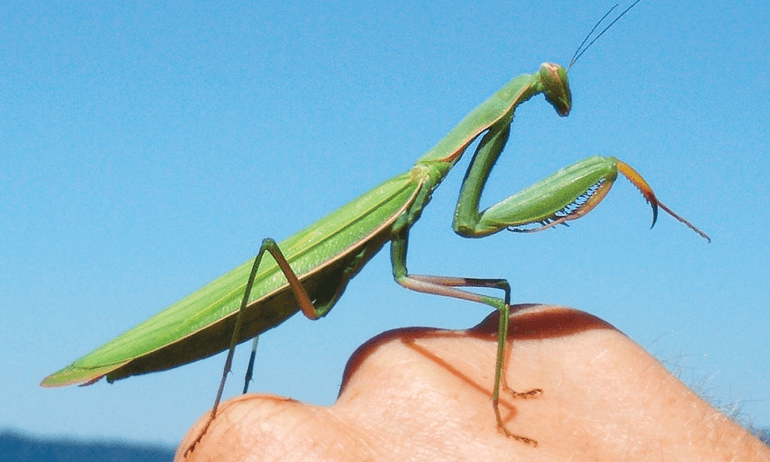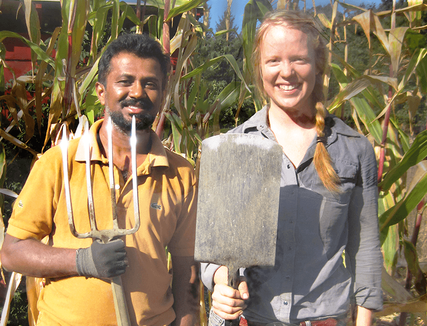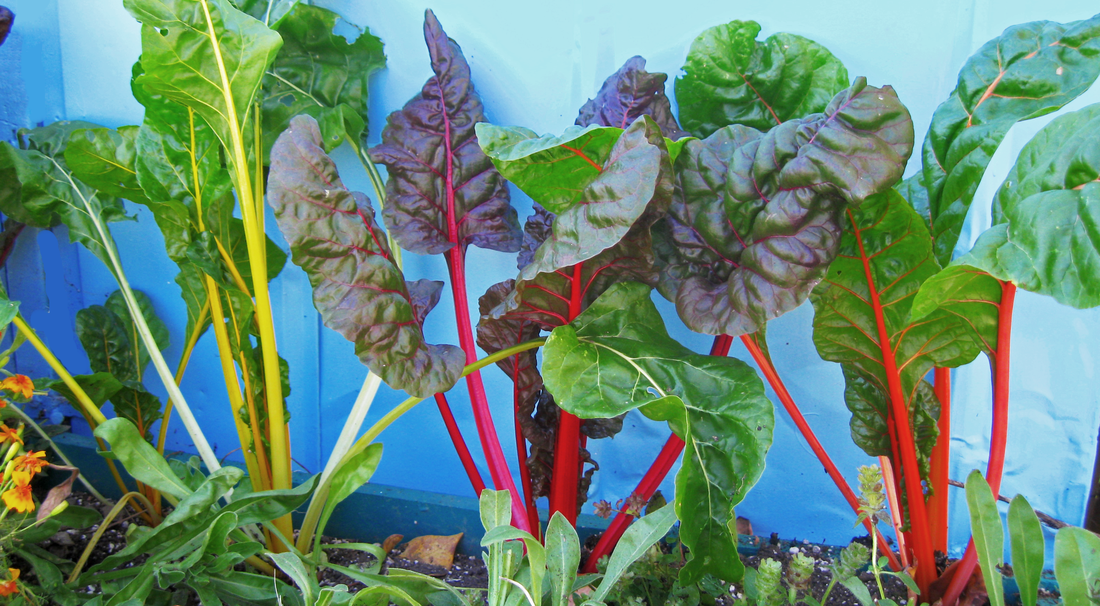|
Many of us just have small chunks of time these September days. But the weather is great for working outdoors. So let's think about Ninja Gardening--focused projects that knock out a priority job in less than an hour (some in mere minutes). Here are my top five:
A Container Salad/Herb Garden: Winter is dark. Winter is muddy and might require a coat and boots for a foray into the garden. So even if you have beds full of winter veg, it's nice to have a container by the kitchen door for grabbing things for dinner (that you forgot to harvest until dinner was already underway.) I like to have salad stuff up out of the mud and near the lights of the house―lettuce, endive, mizuna, green onions. I like to have herbs like thyme and rosemary in pots, close enough that I can run out and grab them while dinner is on the stove. Pull out those dying petunias, work in compost and kelp meal, and plant winter lettuce. It will only take minutes. You'll be happy in December. Compost Pile: It is so satisfying to cut down dead stuff and make a big pile. It's so clever to make your own free fertilizer for next spring. And it is so utterly disastrous when mites and diseases spend the winter on your dead plants instead of getting cooked to death in the compost pile. Trust me: mite, thrip, and aphid eggs build up if you don't compost the plants they live on. Throw used mulch on the pile too. Where to put this compost pile? On the bed where you'll grow tomatoes, corn, or zucchini next summer. It will prevent weeds and fertilize the bed for you. Put your Containers to Bed: Containers (and raised beds) are filled with soil you have to buy, so it's worth a couple of minutes to keep the soil in place and weed-free. Large containers can get next year's fertilizer from a cover crop. Just sow clover or cover crop mix now, under the plants that are still there. (You can do this in the garden at large as well―rough up the soil, broadcast cover crop seed wherever you can reach, under tomatoes, etc. Rake in or mulch lightly. You're done in minutes.) Smaller Pots are Easy: If they won't have anything in them over the winter, cut down the summer flowers. If there are weeds, leave them. If not, cover the surface with dead leaves, weeds, etc. Water one last time. Now, use the drip tray under the pot as a lid. Just turn it upside down over the pot. Without light, the weeds can't grow. Next spring, worms will have turned the dead plant matter into rich soil. And your potting mix will not be washed away or compacted, either. Bulbs: Garlic is one of those things that is so good fresh, and so terrible to run out of. Softneck types keep longer and can be braided, but stiffneck types give you those delicious green garlic stalks to eat. You might want both. And while you're at it, put some daffodil bulbs under your fruit trees to help repel gophers (and make spring cheerful.) Poke holes 4” apart with a stick, rebar, trowel, whatever. Throw a garlic clove in each. Use a rake to cover all the holes in a swipe or two. Ninja gardener! This is the first of two posts. You can also read Return of the Ninja.
3 Comments
Seven more projects to do in a few minutes :
Winterize: Get your perennials and fall crops ready for winter with seaweed. Besides potassium, seaweed contains plant hormones and sugars that increase hardiness. You can use dried kelp meal or soluble seaweed powder. These are easy and fast to apply—kelp meal can just be sprinkled around your plants. (To me, that means run by and throw some around.) Soluble seaweed powder is mixed into water (1 teaspoon to 4 gallons) and dumped around your plants. Both will help harden new growth and thicken the sap so that they don't freeze. Don't give nitrogen fertilizers from now on—they promote the kind of sappy growth that freezes easily. Save some Seeds: I just timed myself, and it took 3 minutes to locate a bucket, cut some dead cilantro plants, and stuff them in. It took 6 minutes to strip off the seeds, shake the chaff to the bottom, and pour the round seeds out into a bowl. It took one minute to use a kitchen strainer to get out the dust and little leaf crumbles. See what I'm getting at? Saving seed sounds more daunting than it is. Sure, some seeds are rare and difficult. Most aren't. Plant Some Glory: Pacific wildflowers are spectacular, and most are winter annuals. They sprout with the fall rains, make a rosette of leaves over the winter, then bloom in spring. That means two things: One, you need to plant them in fall, unless you live where the ground freezes solid. Two, they will act like a cover crop and hold your soil over the winter. Seeds can be hard to find, but I've just listed several kinds here at Quail Seeds. One, phacelia, is even used by farmers as a cover crop. It's also the bees' favorite flower. Full disclosure: This is one time when you do need to take the time to prepare a weed-free planting bed. Wildflowers don't need rich soil, but they have a hard time competing with weeds. So it's not quite ninja, but its so worth it. Bug of the Year: Suddenly everyone seems to have aphids. I find that the beneficial insects can keep the aphids under control IF you have a lot of small nectary flowers like alyssum, IF you don't spray poisons, and IF you prevent ants from carrying new aphids up your plants. So, aphid control is really ant control. Use diatom dust. For larger plants, paint a mixture of coconut oil and mint essential oil in a band on the trunk. Ants won't cross it. A Semi-Wild Garden: A few edibles can be planted haphazardly, left unthinned, compete with weeds, and (usually) survive. They overwinter in my garden, and bloom very early with edible flowers that attract aphid-eating beneficials. I plant them together as a “meadow garden.” Mizuna, Cilantro, Arugula, Turnip, Miner's Lettuce, Texel Greens (Ethiopian Kale), Italian Dandelion, Mustard Greens, and Escarole. (This was the subject of my very first blog post in December 2018.) Anyhow, if you are really pressed for time, it is quick, and better than nothing. Mildew Prevention: September is mildew month, when the air gets cooler and moister. You can't change the weather, but you can change the pH of your plants. You can also coat the leaves with mildew-eating microbes. Do both at once by spraying with compost tea or LAB (lactic acid bacteria--yogurt for plants.) You can find information on these probiotic brews in our How-To section here. Undersow: Most of us know that cover crops do good stuff, and most of us put planting off too long. This year, do it fast and early. It doesn't matter that your tomatoes or whatever are still in the ground. Throw seed for clover, vetch, or rye all around and under those tomatoes. Rake it in or cover with a light layer of straw. If you can rough up the ground and pull some weeds before you start, works even better. It's called undersowing, and it allows you to get those cover crops going while your summer crops are still in place. Takes about 8 minutes to do 100 sq ft. A real ninja move. Everyone loves the summer garden and its produce--tomatoes, corn, squash, green beans, basil... the flavors we wait for all year. But most of us also have regrets. The summer garden can be a demanding taskmaster; things get out of hand in a hurry if you are gone, the weather is wrong, or life intervenes. Well, it's time to lay aside the inevitable failures and lapses. As Eliot Coleman says, Fall is the season of forgiveness.
Fall is a fresh start. The weeds won't grow so fast in winter, and the season of harvest goes for months and months. (Many plants you put in now will still be producing next May.) A few plants by the back door, or a bed of roots and greens for stews and roasting, will go a long way. Fall gardens are leisurely gardens, and Fall foods are comfort food. Now is the time to pull out the plants that are no longer yielding well or never worked out. Till or hoe out the weeds, and start over. If weeds are really severe, wet them down and cover with cardboard. By time your new transplants are ready to go in, the weeds will be dead. Nights are longer, which gives plants more time for repair and recovery from the heat. Plants that you neglected to feed or water enough in summer are giving you a second chance now. Many perennials that bloomed in May are blooming a second time. Plants whose flowering is triggered by short days are budding now. Scarlet runner beans and chia are examples of tropical plants that flower when days are short. Trees and other woody plants are ripening their wood—turning it from green growth to permanent wood. You can help this process, and give them more winter hardiness, by giving them kelp meal or liquid seaweed now. Most weeds are well into flowering and setting seed. If you pull or hoe them out now, they will often stay gone for the rest of the season. (If you don't you'll have a lot of seedlings to contend with next spring.) Your best strategy is to get rid of the weeds you have now, and mulch well around existing plants to prevent new weeds next spring. In empty spots or beds that are finishing up, plant a cover crop like rye or vetch that will smother them and get the ground in shape for easy planting next spring. With the longer nights, watering can often be cut down a bit. Plants don't get so stressed. You may want to adjust the time when you water, too. Mildew often strikes in September, so adjust your schedule now to make sure the soil surface gets dry before nightfall. Finally, and deliciously, now is the time to plant fall crops. As Coleman says, it doesn't matter now what failed or was overrun by weeds in summer—you can hoe out your mistakes and start with a clean slate. Fall and winter gardens are so much easier in many ways. They grow during the period when there are fewer weeds. They won't need irrigation after the rains start. Instead of a short window when you have to either use or preserve them, winter crops wait in the ground until you want them. And on a cold rainy night it is pretty special to come home to your own vegetables instead of having to run to the store. |
AuthorJamie Chevalier lives and gardens on a river in the Coast Range of Northern California. She has gardened professionally in Alaska and California, as well as living in a remote cabin, commercial fishing, and working with seeds. She is the proprietor of Quail Seeds. Archives
July 2024
|
- Home
-
Shop
- Plant for Summer
-
Vegetable Seeds
>
- Arugula
- Beans
- Beets
- Broccoli and Cima di Rapa
- Cabbage
- Carrots & Roots
- Celery
- Chard
- Corn
- Cucumber
- Eggplant
- Fennel
- Genepools and Landrace Gardening
- Greens
- Kale and Collards
- Lettuce
- Melons
- Oil Crops
- Okra
- Open-Source Seeds (OSSI)
- Onions and Leeks
- Peas
- Peppers
- Spinach
- Squash & Pumpkins
- Sunflowers
- Tomatoes
- Tomatillos/Husk Cherries
- Turnips and Rutabagas
- Perennial Vegetables >
- Flower Seeds
- Herb Seeds >
- Seed Collections
- Pollinator and Pest Control Plants >
- Grains >
- Cover Crops >
- Open Source (OSSI)
- Start these Indoors
- People behind the Seeds >
- Companion Plants
- Recipes >
- Fast, Fresh Food
- Plant for Spring >
- Plant for Fall >
- About Us.
- Blog
- HOW-TO
- Mid-to-Late Summer Sowings
Proudly powered by Weebly
- Home
-
Shop
- Plant for Summer
-
Vegetable Seeds
>
- Arugula
- Beans
- Beets
- Broccoli and Cima di Rapa
- Cabbage
- Carrots & Roots
- Celery
- Chard
- Corn
- Cucumber
- Eggplant
- Fennel
- Genepools and Landrace Gardening
- Greens
- Kale and Collards
- Lettuce
- Melons
- Oil Crops
- Okra
- Open-Source Seeds (OSSI)
- Onions and Leeks
- Peas
- Peppers
- Spinach
- Squash & Pumpkins
- Sunflowers
- Tomatoes
- Tomatillos/Husk Cherries
- Turnips and Rutabagas
- Perennial Vegetables >
- Flower Seeds
- Herb Seeds >
- Seed Collections
- Pollinator and Pest Control Plants >
- Grains >
- Cover Crops >
- Open Source (OSSI)
- Start these Indoors
- People behind the Seeds >
- Companion Plants
- Recipes >
- Fast, Fresh Food
- Plant for Spring >
- Plant for Fall >
- About Us.
- Blog
- HOW-TO
- Mid-to-Late Summer Sowings




 RSS Feed
RSS Feed